Tarpon: “Three Days in Key West”
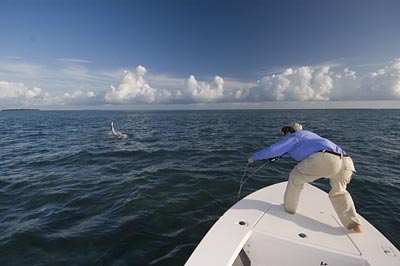
The author bows to an oceanside tarpon just south of Margaritaville. Rusty Chinnis photo
FISHING GUIDES are fond of sayings, and here is one of their harsher assessments: “The angler is just a weak link between the guide and the fish.” On a splendid May morning south of Key West, I am about to test the tensile strength of that maxim, tightly drawn, as it is, along the imaginary line between my guide and about seventy-five tarpon fresh in from the ocean. Many of these fish weigh more than a hundred pounds. None of them are more than sixty feet away.
The guide, Marshall Cutchin, had spotted the school well out at sea just after dawn. We’d waited nearly twenty minutes for them to porpoise their way into shallower water, and Cutchin is now throwing himself against the pushpole with the force of a vaulter just to keep up. His labors are giving me shot after perfect shot at this aquarama of “happy” fish, swimming gill to gill, gulping sunshine, chipping away at my composure with their yawning indifference. By the fifteenth toss, advanced casting palsy has set in, and my right leg is pumping like a sewing machine. Then, magically, an 80-pounder flows off the dark, spectral mass of the main school.
“He’s on it!” Marshall hisses as the tarpon makes a final tail pump, slams his bear-trap jaws around the orange feathers, and turns broadside. At first, I am stymied by the sheer inertial mass of this fish. He’s lodged sideways in the shallows right at my feet, and I cannot move him.
Expecting a run, I glance down and fumble for the drag knob at the precise moment the fish rages out of the tourmaline water, shimmering silver, longer than an ironing board and twice as hot. With no more than a sideways glance, he promptly snaps the tippet. My thumb and forefinger are still glued to the drag dial, slack jaw flapping in the breeze.
“You didn’t bow,” Marshall says, as the school explodes in three different directions.
“I, uh, I thought my drag was loose,” I stammer, sitting down on the deck. I have to sit down.
Cutchin calmly plants the pole again and sets his sights on the far end of the flat. He’s seen it all before. “Don’t touch the drag,” he offers, adding one more saying to my thin but rapidly growing book of tarpon wisdom.
….
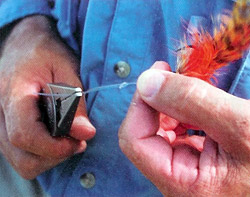
A Homer Rhodes loop knot is an excellent way of attaching heavy shock tippet to a tarpon fly. Steve Walburn photo
Compared with the Upper Keys — where there are nearly two hundred fishing guides in Islamorada alone — Key West tarpon are comparatively lightly fished on the fly. Although the tarpon here are “fresher” fish that have not yet migrated through the more northerly gauntlet of anglers, there are fewer fly guides who know the Key West area well, and it’s harder to fish because of the lack of defined migration highways. It also presents a larger area of flats and basins to cover.
As recently as the mid 1980s, it was still a frontier town for tarpon chasers, with fewer than a dozen qualified tarpon guides based in the Conch Republic and none who could afford to specialize exclusively in fly fishing. By about 1988, when other Key West guides often still resorted to bait, Cutchin was one of if not the first to go to fly-rodding only. Although he no longer poles a boat for hire, among the Keys tarpon cognoscenti he is still considered one of the region’s seminal fly-fishing guides. A favorite guide of Abel reels founder Steve Abel, Cutchin also spent at least twenty-five days a year on the water with all-time permit guru Del Brown. Modest to a fault, he is most likely the best guide you have never heard of.
Today, in addition to having made a successful transition from guiding to web-marketing manager for a major corporation, Cutchin is also the man behind the curtain at the popular fly-fishing website MIDCURRENT.
So that leaves me, the alleged weak link.
Before Cutchin called last winter and offered to guide me on his old stomping grounds, I’d had limited experience with tarpon. Years ago, during a nearly fishless trip to Caribbean Costa Rica, I botched the hook-set on two monsters that struck right at my toes off the bow of a small john boat. After losing two of these jungle giants back to back on the last day of a maddening week, I could have strangled a howler monkey. Since then, my only other shots at tarpon had been for juvenile fish in Florida canals. This was my chance to jump into the big leagues.
On top of that, I timed the trip just right, hitting a stretch reminiscent of “The Good Ole Days,” when, I am told, it was not unusual to see a thousand tarpon swim past the bow in a hard day’s fishing. In three days, we saw approximately 750 fish. I hooked seven, jumped five, and landed two. But once you have proved lucky enough to position yourself on that taut line between a great guide and a good fish, the rest is up to you. And from the dreaded “trout set” to forgetting to bow, from casting behind the fish to not casting at all, the sight of a huge tarpon ten feet from your tip top is enough to rattle a rookie to the grip.
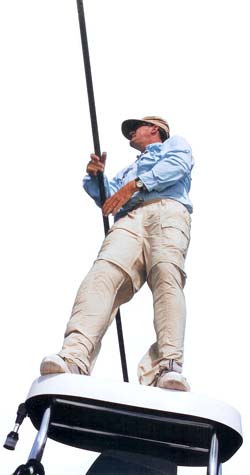
Steve Walburn photo
“Right there! Right there!”
The fish is right there, lolling at eleven o’clock off the bow, a couple of decades’ worth of tarpon flesh laid up regally on the shallow center of a gulfside basin in the Key West National Wildlife Refuge, where giant tarpon come to snooze.
Although the fish is as big around as a telephone pole, I cannot see him through the stained water until he materializes nose-to-bow, floating there above the waving aquatic grasses like a giant helium pig at a Floyd concert. He is suspended, transcendent. And in that split second I am vapor locked with adrenaline.
“Get it in the water!” Marshall says. Yet, my first reaction is to freeze every muscle for fear of blowing out the fish. Turns out, big tarpon aren’t so likely to spook from a deftly waved fly rod as they are from your prolonged, if statuesque, presence in their bedroom. If you suddenly see a fish that close, you don’t wait for a better angle or a quieter approach. You snap roll the fly out and get the damn thing in the water or the fish will be gone, rocking the boat with his Learjet tail fin.
This instinct to stay motionless at first sight was a reaction I found remarkably difficult to overcome, and until the second day, nearly every close encounter suffered from that momentary pause, as if I had spotted a deer in close quarters rather than a fish. But one hallmark of great guides is that they let you make mistakes, and by the end of the first day, I had screwed up enough sudden shots to capitalize on those that unfolded more casually.
We’d been bouncing between the Refuge to hunt for laid-up fish and the oceanside flats to intercept cruisers. Twenty or so casts on the day had earned several follows, and by three o’clock we were staked out over some sand patches within knee-walking distance of Duval Street. Until that point, many of my casts had been behind the fish, or across their back, or intersecting their line of travel with an in-your-face retrieve.
“Prey doesn’t usually swim toward the predator,” Marshall kept telling me, and when we spotted a trio of fifty-pounders milling the flat, I’d finally put the fly in a tarpon’s proper field of view, stripped it smartly away, and provoked a strike. The fight lasted perhaps five minutes, until the fish tired of my ineffectual winching, hammered out a third long run, jumped, and spit good-bye at me. But by then I had decided that tarpon fishing is a bit like rodeo: You don’t have to ride the bull into the ground to call the day a success.
….
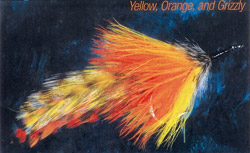
Yellow, Orange and Grizzly
Back in the 1890s, when Key West was still the county seat of practically all of south Florida, Marshall Cutchin’s great- great-grandfather was its mayor. Having grown up hearing tales about his storied elder in this Garden of Eden, where “there wasn’t a tree with fruit that you couldn’t eat,” Cutchin began traveling to the south end of the country in his late teens. During a sojourn in 1979, he booked a fishing trip with local guide Jan Isley, and that day watched up to 1,200 tarpon swim past the boat. It was this “spectacle of nature” that lured him back repeatedly until, in 1985, he decided to take a year off from his job in publishing just to fish. He bought a used Action Craft, hauled it down to Key West, and started fishing by himself.
When Cutchin humbly asked Isley how to find fish, his first mentor replied, “Go pick a flat, sit on it all day long, and don’t move.” “I did that a lot. In those days, no one would tell anyone a thing. You had to figure it out yourself,” recalls Cutchin, whose first saltwater fish on a fly rod was a 100-pound tarpon. He soon started taking on Isley’s overflow clients, and in 1986 was a guide on the winning four-man team during Key West’s first fly-only tournament. The team included West Coast fly-fishing pioneer Dan Blanton, and Cutchin was almost instantly in demand as a guide.
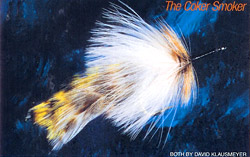
Coker Smoker
“That annealed me. I got to fish with so many good anglers in such a concentrated period. It showed me what guiding could be as a profession,” he says.
In 1988, Cutchin declared fly fishing as his sole method of angling, and during the next decade forged a reputation as “one of the best guides in the world,” according to SFF contributor Chico Fernandez.
“Every year the [tarpon] got tougher to feed and every year you had to change strategy,” remembers Cutchin. “The traditional way to fish was to stake out over a white patch. Then the Tarpon Wear boom hit in the late eighties, and to catch fish you had to go where there were no other boats. That’s how I found a lot of my laid-up spots.” Like many veteran guides, Cutchin prefers to hunt for laid-up fish. “It’s just more challenging. The fish are more sensitive because they are isolated rather than in a school. It demands more accurate casting, more subtle movement of the fly, and more of a feel for when to strike,” he says.
Tier’s Notes
Both of these flies are Fitz Coker style tarpon flies, and they can be tied in almost any color. There are several things that make them distinctive. First, there is a ball of thread wrapped about one eye’s length down the bend that nudges the tail and wing upward. This keeps the fly from fouling during the cast and also helps the fly track straight in the water. Second, the marabou collar is tied in well forward of the bend. They look nice anywhere from one third of the way forward to over halfway forward. This collar undulates in the water and gives the illusion of a living body. The marabou is also very easy to cast, more so than rabbit strip.
Additionally, I prefer capon necks for all tarpon flies. They are wider than normal hackle and give a better profile. They also have a thick, stiff stem that resists fouling. For hooks, I am partial to the Gamakatsu, but Marshall’s choice has always been a 3/0 Mustad AC3406B.
– Craig Jansen
Key West newcomers, on the other hand, are often partial to the oceanside fishing, where there can be an almost video-game predictability to wave after wave of gray torpedoes skimming along ancient paths in crystalline water, each group following the other from mysterious points of origin in southerly oceans. These days, the fish seem to hang farther off the flats, but on our second day we had at least 500 fish swim past our skiff in singles, pairs, and scores. No one knows quite how tarpon track each other as they move like aquatic caribou up toward the migratory dividing wedge that is Key West. Perhaps they use ocean topography, currents, water temperatures, or some form of “snail trail” to mark their way, but each spring they move along the same general paths, pausing to rest and feed in the same inlets, channels, and backcountry boudoirs.
Though Cutchin seems to know them all, by midmorning on day two we are staked out over the same sand patches as the day before. It’s been a proven producer, revealing string after string of fish. I have recovered my balance after our losing bout with the big school at first light, and I have in fact jumped another two fish up to eighty pounds. Feeding them hasn’t been all that hard. Making them keep their food down is proving more difficult.
“Here they come. Three fish. Straight at you, pretty fast at about one-hundred yards.” Although I have 20/20 vision, Cutchin is still seeing them three times farther up the road than I am. But by midday, we’ve cast to enough tarpon to have achieved a kind of synergy, a chain of angling events that begins with the guide announcing distant fish, anticipating my rhythm, calmly winding up my casting clock for fish that he knows I have not yet seen.
“Cast whenever you think you can reach them, ” he says.
I make a false cast and in mid-stroke pick up their shadowy forms cruising head-on. Cast abruptly checked, my fly drops fifty feet yonder and is already pulsing away when the second shadow veers toward it. The fish pumps, pumps, yawns… and then wags his head in slow-motion fury.
This one is a “catchable” fifty-pounder that, after a solid fifteen minutes, succumbs to nothing more than brute force and well-tied knots. Hauling him toward the boat, I am thinking about my camera. The hero shot. As a big-tarpon novice, it is impossible not to. But at the last moment, with Cutchin’s grip firmly on the fish’s lower jaw, an abraded leader suddenly snaps, and the fish defiantly swims away. My second landing of the trip on the following day ends the same way: the weak link now a jiggered shock tippet with flawed strength or perfect timing, depending on how you look at it.
Although we had planned for a fourth day, the wind finally got the better of us, and by the final dawn it is “humpin’ a woofer.” Cutchin still gets a kick out of hearing younger guides hipply tossing around his old phrase whenever it is so windy down in the Keys that “you might as well go home and screw the dog.”
Woofer winds or not, the truth is that after nine hours a day as the sole angler on the bow, my broken back had just about fused to my fallen arches. By the third day, I was happy to have a photographer along to share the pain because, up until that point, I had not been able to convince Cutchin to pick up the fly rod. “It’s a lot easier to guide,” he demurs. “You can choose to remain calm.”
But that’s a gentle lie.
It is the wind. The tide. The vector of boat and intersecting fish. The approaching clouds and attitude of the sun. A mismanaged fly line unwittingly coiled around an ankle. The customer’s skill and his luck. From the platform, it’s the variables in constant flux that make the guide as much the angler as the client.
However, in twelve years of guiding and another decade of annual pilgrimages to Key West, Cutchin says one thing never seems to change. “People who catch their first big tarpon always tell me they wish they had gotten started earlier.” Of course, later is better than never, and when you finally do make it to the buzzer, nothing else really matters. The ride is over. Your scores are in, and the bull is back in the pen.











